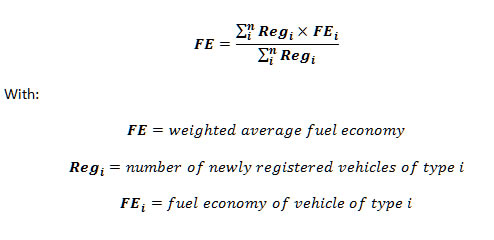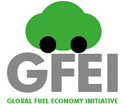
Draft guideline for fuel economy baseline-setting
1. Introduction
The following document provides an overview on the necessary steps, which needs to be taken to set the fuel economy baseline in a given country in a given year. It furthermore comprises links to relevant sources for data to fill eventual gaps in the national vehicle registration data, as well as useful hints on the methodological approach.
The overall aim of the baseline-setting exercise is to obtain information on weighted average fuel economy of newly registered cars for at least one historic year. This baseline fuel economy information is required to:
- Evaluate the status quo
- Define future average fuel economy targets
- Measure progress of weighted average fuel economy of newly registered cars
In a second step, the data can be completed to obtain information on:
- Vehicle market segmentation by size and fuel economy class
- Average vehicle purchase price
This additional information is necessary to use the FEPIT tool as well as a tool to design feebates (link to feebate tool), which are provided by GFEI for free. These simple and user-friendly models can help:
- Identifying appropriate policy measures to reach the fuel economy target (FEPIT)
- Quantifying the policy impact in terms of estimated fuel economy improvements (FEPIT)
- Designing a feebate scheme (Feebate tool)
Guidelines as well as methodology reports for the respective tools can be found online.
2. Data requirements for baseline setting
 |
The fuel economy baseline should only include vehicles, which are registered for the first time in a given year in the respective country. Depending on the country, this set of vehicles includes new cars as well as used imported cars. |
Minimum required data
The minimum required data comprises information, which is necessary to calculate the average weighted fuel economy for newly registered cars for at least one historic year:
Number of newly registered vehicles by:
- Vehicle make (e.g. Toyota)
- Vehicle model (e.g. Corolla)
- Model production year - important for used imports (e.g. 2007)
- Engine displacement (e.g. 1,800 ccm or 1.8 l)
- Engine power (e.g. 80 kW)
- Fuel type (e.g. gasoline, diesel, LPG, CNG, electricity)
- Rated fuel economy (Lge/100km) or specific carbon emissions per km (gCO2 per km) and the respective test cycle basis (NEDC, CAFE (FTP), JC08)
In most cases, the rated fuel economy (Lge/100km) or specific carbon emissions per km (gCO2 per km) data are not part of the national registration data, and will need to be filled with the help of freely available sources for tested fuel economy of new vehicles, which are listed in Table 1.
Therefore, the combination of vehicle make and model, production year, engine displacement, engine power and fuel type information is used to allocate fuel economy values from the freely available data sources to the national registration data. In order to minimize the effort for adding the fuel economy data, the national registration data needs to be cleaned and aggregated using the above mentioned criteria.
Due to the diversity of the vehicle market, it will most likely not be possible to complete fuel economy data for each and every newly registered vehicle – the accuracy of the fuel economy baseline is sufficient, if fuel economy data can be added to at least 85% of all newly registered vehicles in one year. In many markets, based on the above mentioned criteria, a selection of 40 to 50 different car models is sufficient to obtain the minimum fuel economy data filling rate.
In many cases, instead of using engine displacement, engine power and fuel type altogether, a combination of either engine displacement or engine power and the respective fuel type is sufficiently accurate to identify correct tested fuel economy values.
Additional data to improve accuracy of the collected fuel economy data
When available, additional data can help to improve the accuracy of the completed fuel economy data. This additional data might comprise:
- Transmission type (automatic/manual, number of gears)
- Axle configuration (i.e. number of driven wheels, 4x2, 4x4)
Additional data for feebate tool
In order to enable the use the feebate tool with the baseline data, additional information needs to be collected:
- Vehicle price
- Vehicle footprint (wheelbase times track width) OR vehicle weight
Table 1 • Sources for test cycle fuel economy of new cars
Country |
Source |
Australia |
Green Vehicle Guide Factsheets |
Brazil |
Programa Brasiliero de Etiquetagem |
Chile |
Comparador de Autos |
China |
轻型汽车燃料消耗量通告 通告日期 |
European Union (EEA) |
Monitoring of CO2 emissions from passenger cars – Regulation 443/2009 |
http://www.eea.europa.eu/data-and-maps/data/co2-cars-emission-8#tab-european-data |
|
France |
Consommation conventionnelles de carburant et émissions de gaz carbonique |
http://www2.ademe.fr/servlet/getDoc?cid=96&m=3&id=52820&p1=00&p2=12&ref=17597 |
|
Japan |
自動車燃費一覧 |
Mexico |
Indicadores de Eficiencia Energética y Emisiones Vehiculares |
Singapore |
One Motoring Fuel Cost Calculator |
https://vrl.lta.gov.sg/lta/vrl/action/pubfunc?ID=FuelCostCalculator |
|
South Korea |
소비자 체감에 부합하는 새로운 연비표시 방법 확정 |
South Africa |
COMPARATIVE PASSENGER CAR FUEL ECONOMY AND CO2 EMISSIONS DATA |
http://www.naamsa.co.za/ecelabels/ |
|
Switzerland |
Automobil Revue catalogue |
UK |
Car Fuel Data Booklet |
To download the data |
|
http://carfueldata.dft.gov.uk/downloads/ |
|
US |
DoE / EPA Fuel Economy ratings |
To download the data |
|
3. Calculation of the baseline fuel economy
Once fuel economy data is available for at least 85% of the newly registered vehicles, weighted average fuel economy can be calculated using the following equation:

 |
To correctly use rated fuel economy, the different energy densities of gasoline and diesel need to be taken into account. Therefore, volumetric fuel economy values (litres per 100km) of diesel cars need to be normalized to the energy content of gasoline – i.e. they need to be converted to litres of gasoline equivalent per 100km (Lge/100km). Similarly, fuel economy values for cars which have been retrofitted to alternative fuels like LPG or CNG need to be adjusted using the factors provided in Table 2. |
Table 2 • Conversion factors to normalize volumetric fuel economy values to Litres of Gasoline equivalents per 100km and for CNG and LPG fuel economy adjustment
L/100km to Lge/100km |
Diesel |
*1.08 |
Retrofit adjustment |
CNG |
*1.12 |
LPG |
*1.15 |
Source for LPG/CNG retrofit fuel economy: IEA ETSAP 2010
 |
In many regions, imported vehicles might come from different main markets, namely Europe, North America and Japan. Within these regions, different test cycles to measure tested fuel economy of new cars exist. These test cycles comprise the European NEDC, the CAFE (combined FTP75 and HWFET) in the United States as well as the JC08 in Japan. Table 3 provides an overview of used test cycles by country. In order to make the collected fuel economy data for different vehicles comparable, the data needs to be normalized to one test cycle basis, e.g. the NEDC. Therefore, conversion factors provided in Table 4 need to be applied (from ICCT, 2014). Alternatively, the ICCT online conversion tool http://www.theicct.org/sites/default/files/info-tools/pvstds/Conversion_tool_locked_20141121.xlsx can be used as well. In case fuel economy data (Lge/100km) need to be converted to specific emission data (gCO2/km), the conversion factors provided in Table 5 for gasoline, diesel, CNG and LPG can be used. |
Table 3 • Type approval test cycle by country
NEDC |
Argentina, Australia (NEDC like), Chile, China, Egypt, EU, India (NEDC like), Indonesia, Macedonia, Malaysia, Peru, Philippines, Russia (NEDC like), Singapore, South Africa, Thailand, Turkey, Ukraine, Vietnam |
CAFE |
Brazil, Canada, Mexico, South Korea, United States |
JC08 |
Japan |
Table 4 • Test cycle conversion factors
Gasoline |
Unit: gCO2 per km |
NEDC to CAFE |
CAFE |
= |
0.8658 |
* |
NEDC |
+ |
14.076 |
CAFE to NEDC |
NEDC |
= |
1.1325 |
* |
CAFE |
- |
13.739 |
||
JC08 to CAFE |
CAFE |
= |
0.7212 |
* |
JC08 |
+ |
36.736 |
||
CAFE to JC08 |
JC08 |
= |
1.2749 |
* |
CAFE |
- |
38.423 |
||
JC08 to NEDC |
NEDC |
= |
0.8457 |
* |
JC08 |
+ |
24.840 |
||
NEDC to JC08 |
JC08 |
= |
1.1430 |
* |
NEDC |
- |
24.907 |
||
Diesel |
Unit: gCO2 per km |
NEDC to CAFE |
CAFE |
= |
0.7683 |
* |
NEDC |
+ |
23.928 |
CAFE to NEDC |
NEDC |
= |
1.2209 |
* |
CAFE |
- |
21.218 |
||
JC08 to CAFE |
CAFE |
= |
0.6050 |
* |
JC08 |
+ |
44.338 |
||
CAFE to JC08 |
JC08 |
= |
1.3691 |
* |
CAFE |
- |
38.393 |
||
JC08 to NEDC |
NEDC |
= |
0.8230 |
* |
JC08 |
+ |
21.950 |
||
NEDC to JC08 |
JC08 |
= |
1.1720 |
* |
NEDC |
- |
21.122 |
source: ICCT 2014
Table 5 • Factors to convert fuel economy (Lge/100km) to carbon emissions (gCO2/km)
Lge/100km to gCO2/km |
Gasoline |
*23.2 |
Diesel |
*24.8 |
|
CNG |
*18.8 |
|
LPG |
*21.1 |
4. Vehicle segmentation
The choice of the vehicle segments, which are taken into account for baseline setting, depends on the scope of the fuel economy policies, which should be developed based on the obtained information.
In most cases, the baseline will only be set for passenger cars comparable to the European class M1 (vehicles used for the carriage of passengers and comprising not more than eight seats in addition to the driver's seat).
In principle, a separate baseline could also be set for light commercial vehicles comparable to the European class N1 (vehicles used for the carriage of goods and having a maximum mass not exceeding 3.5 tonnes). In the case of light commercial vehicles, fuel economy data is also available due to the fact that fuel economy standards already exist in many main car markets of the world.
5. Regional transfer of fuel economy baseline data
In cases where the national registration data contains insufficient information for baseline setting, fuel economy baselines might be adopted from similar markets. Whether vehicle markets are similar or not depends on the following characteristics:
- Average per capita income
- Fuel price at the station
- Vehicle taxation schemes
- Existence of national car manufacturers
- Vehicle import legislation
- Origin of imported vehicles
- Average age of imported vehicles
In order to better reflect region specific circumstances, the adoption of the baseline might be supplemented with corrections based on estimates on higher or lower penetration of certain vehicle models or assumptions on average age.
However, since implementation of any effective fuel economy policy will be based on the above mentioned minimum required data, this data needs to be collected once the policies will be enacted.
6. References
The following sources of information for fuel economy baselines, conversion tools and downloads can assist in the development of your baseline database:
- ICCT 2014 Development of test cycle conversion factors among worldwide light duty vehicle CO2 emission standards, The International Council on Clean Transportation, Washington D.C.
- ETSAP 2010 Automotive LPG and Natural Gas Engines, IEA ETSAP Technology Brief, http://www.etsap.org/E-techDS/PDF/T03_LPG-CH4_eng-GS-gct-AD.pdf







